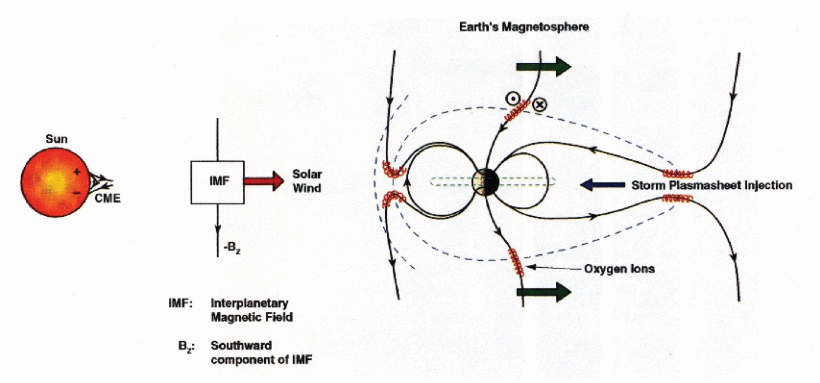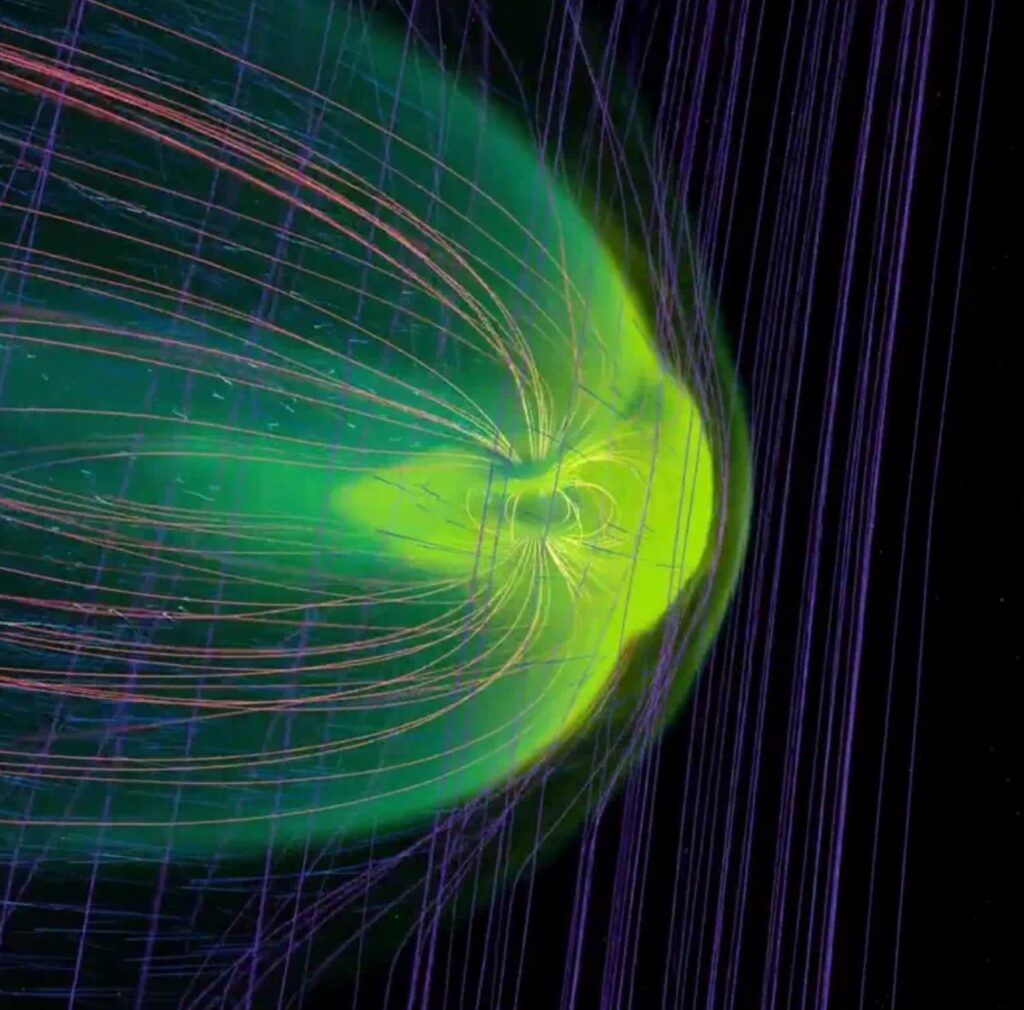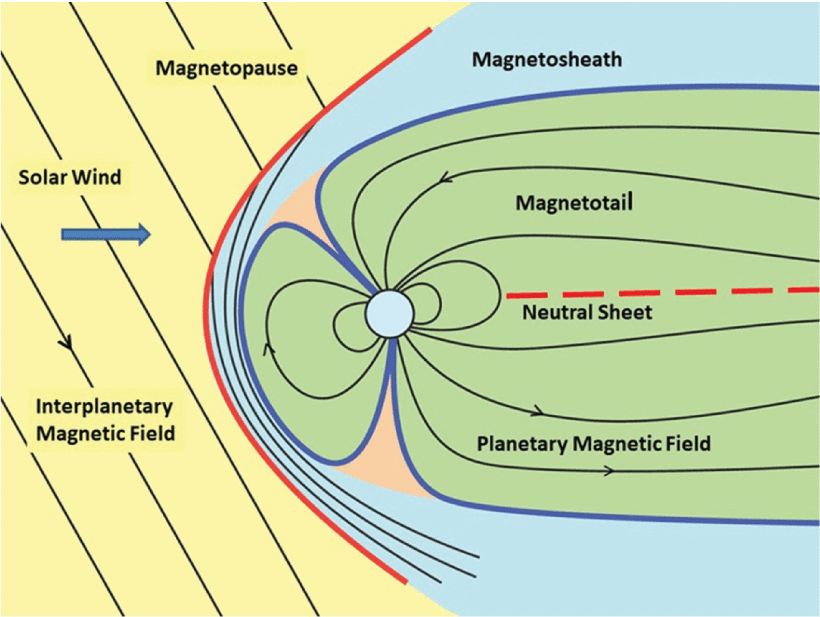The Bz! Finally.
The Interplanetary Magnetic Field (IMF) represents the Sun’s magnetic field carried outward through the solar system by the solar wind. This isn’t some theoretical construct – it’s a measurable, dynamic force that extends from the Sun’s photosphere all the way to the heliopause, the boundary where our solar system meets interstellar space. The IMF originates from magnetic field lines that become “frozen” into the solar wind plasma as it accelerates away from the Sun’s corona. Think of it like invisible rubber bands stretched across millions of miles of space, constantly shifting and rotating as they’re dragged along by the charged particle stream. 
Magnetic field lines, do they break? As the Sun rotates every 27 days, these magnetic field lines get twisted into what’s called the Parker spiral – imagine a garden sprinkler spinning while water shoots out, creating curved arcs. The IMF strength typically measures around 5 nanotesla near Earth’s orbit, but it’s not constant. Solar storms, coronal mass ejections, and other space weather events can dramatically alter both the strength and orientation of the IMF, sometimes by orders of magnitude.
Here’s where the IMF becomes your radio’s best friend or worst enemy.
When the Interplanetary Magnetic Field reaches Earth, its orientation determines whether we get gentle space weather or a full-blown geomagnetic beating. The key player here is the IMF’s Bz component – that north-south orientation we talked about. When Bz points northward, it’s like having a bouncer at the door of Earth’s magnetosphere, keeping most of the solar wind’s energy out. But when Bz flips southward, it’s game over for stable HF conditions.

We can deal with a little Bz Southward, like -1.3nT, but beyond that the field starts to get soupy, like a laser hitting a cloud, you never know where it (or your signal) will exit.
That southward IMF orientation allows magnetic reconnection to occur on the dayside magnetosphere, essentially opening floodgates for solar wind energy to pour into Earth’s magnetic field system. This energy gets channeled toward the polar regions, accelerating particles that slam into the ionosphere with tremendous force. The result? Massive ionospheric disturbances that can make your carefully planned HF contacts disappear faster than a New York minute. Think of it like someone suddenly cranking up the static electricity in the very layer of atmosphere your radio waves depend on for propagation.
Here’s how IMF variations will wreck your HF game plan:
- Geomagnetic Storm Onset: When the IMF rotates from northward to southward and stays there, you’re looking at the rapid onset of a geomagnetic storm. The stronger and more sustained that southward Bz, the more severe the storm. During these events, the ionosphere becomes a chaotic mess of enhanced absorption and unstable reflection characteristics.
- Auroral Zone Blackouts: Strong southward IMF drives particles deep into the auroral zones, creating intense auroral displays that are absolutely beautiful to watch but brutal for radio communications. The same particle precipitation that creates those dancing lights also creates a radio-absorbing curtain across high-latitude paths. Your 20-meter signal to Europe might as well be getting swallowed by a black hole.
- Sudden Ionospheric Disturbances (SIDs): Rapid IMF changes, especially during solar flare events, can trigger SIDs that cause immediate HF blackouts on the sunlit side of Earth. These aren’t gradual degradations – your signal can literally vanish mid-QSO when the ionosphere suddenly becomes opaque to HF frequencies.
The IMF’s rotation period follows the Sun’s 27-day cycle, creating somewhat predictable patterns in geomagnetic activity. But here’s the kicker – CMEs and solar flares can completely scramble the normal IMF structure, creating chaotic magnetic field orientations that persist for days. During these periods, traditional propagation predictions become nearly worthless, and even the most experienced operators find themselves chasing phantom signals and dealing with constantly shifting MUF conditions that make frequency selection feel like throwing darts blindfolded.
The IMF’s orientation is critical for understanding space weather effects on Earth. When the IMF points southward (negative Bz component), it can connect with Earth’s magnetosphere through a process called magnetic reconnection. This is when things get interesting for radio operators and anyone dependent on satellite communications. The southward IMF acts like a key, unlocking Earth’s magnetic defenses and allowing solar wind energy to pour into our magnetosphere, triggering geomagnetic storms that can disrupt HF propagation for hours or days.
Monitoring IMF data is essential for predicting space weather impacts. Real-time measurements come from satellites positioned at the L1 Lagrange point, about 1.5 million kilometers upstream from Earth. The Advanced Composition Explorer (ACE) and Deep Space Climate Observatory (DSCOVR) provide continuous IMF readings that feed into space weather prediction models. When you see rapid IMF fluctuations or sustained southward orientations in the data, you can expect potential disruptions to HF communications, GPS accuracy, and power grid stability within 15-60 minutes – the time it takes for solar wind changes to propagate from L1 to Earth.
Scientific Nerd info
The Interplanetary Magnetic Field’s interaction with Earth’s magnetosphere is the primary driver of space weather effects that impact HF radio communications. The critical factor is the IMF’s north-south orientation, specifically the Bz component. When the IMF points northward, magnetic field lines remain relatively closed, limiting solar wind energy transfer to Earth’s magnetosphere. However, when the IMF rotates southward, it enables magnetic reconnection at the magnetopause, allowing solar wind energy to efficiently couple into the magnetospheric system and drive geomagnetic activity.

This coupling process initiates a well-understood chain of magnetosphere-ionosphere interactions that directly affect radio wave propagation. The solar wind energy channeled through reconnection accelerates charged particles toward Earth’s polar regions along magnetic field lines. These precipitating particles collide with atmospheric constituents in the ionosphere, increasing electron density and creating structured irregularities that fundamentally alter the electromagnetic environment through which HF signals propagate. The enhanced ionization particularly affects the D-region (60-90 km altitude) and auroral E-region, both critical for HF absorption and reflection characteristics.
Several specific propagation effects result from IMF-driven disturbances:
Absorption Enhancement:
Increased D-region electron density from particle precipitation creates stronger collisional absorption of HF waves. This absorption follows predictable frequency dependencies, with lower frequencies experiencing proportionally greater attenuation. The effect is quantified through riometer measurements and correlates directly with geomagnetic activity indices.
Ionospheric Irregularities:
The enhanced electric fields and particle precipitation create field-aligned irregularities that cause signal scintillation. These irregularities scatter radio waves, producing rapid amplitude and phase fluctuations that degrade communication quality, particularly on trans-auroral and polar paths.
Dynamic MUF Variations:
Geomagnetic disturbances alter F-region electron density distributions through enhanced electric fields and neutral atmosphere heating. This creates unpredictable changes in the Maximum Usable Frequency, making traditional propagation predictions unreliable during active periods.
The temporal evolution of IMF effects follows the solar wind transit time from monitoring satellites to Earth (typically 30-60 minutes), followed by magnetospheric response times of 15-30 minutes. Storm main phases develop over 2-6 hours, with recovery extending 24-72 hours depending on the magnitude and duration of southward IMF exposure. Understanding these timescales allows operators to anticipate propagation changes and adjust operating strategies accordingly during periods of enhanced geomagnetic activity.
In a Nutshell for the Radio Ham:
The Interplanetary Magnetic Field (IMF) is essentially the Sun’s magnetic field carried through space by the solar wind, and its orientation when it hits Earth determines whether your HF bands will cooperate or completely tank. Think of it as a cosmic switch – when the IMF (Bz) points northward, Earth’s magnetic field acts like a shield, keeping most solar wind energy out and your propagation relatively stable.
But when that (Bz) flips southward and stays there, it’s like opening the floodgates, allowing solar wind energy to pour into Earth’s magnetosphere and create the geomagnetic storms that mess with the ionosphere.
This is the key mechanism behind those frustrating days when your 20-meter Europeans disappear, your 40-meter signals get absorbed into nothing, and the MUF predictions become about as reliable as weather forecasts – because a sustained southward (Bz) can trigger hours or days of ionospheric chaos that makes HF propagation unpredictable and often impossible on affected paths.
Bz Impact on HF Radio Propagation
| Bz Value (nT) | Coupling Strength | Expected HF Impact | Kp Index Correlation |
|---|---|---|---|
| > +5 | Minimal | Optimal HF conditions; stable F-layer; high MUF; minimal absorption. | Kp 0–2 |
| 0 to –5 | Weak | Slight MUF suppression at high latitudes; minor D-layer absorption; 40m/80m bands remain reliable. | Kp 2–3 |
| –5 to –10 | Moderate | MUF depression; increased D-layer absorption; polar paths degraded; potential for auroral absorption. | Kp 4–5 |
| –10 to –20 | Strong | Significant MUF drop; widespread D-layer absorption; HF blackouts possible, especially at high latitudes. | Kp 6–7 |
| < –20 | Severe | Major geomagnetic storms; extensive HF disruptions; blackouts on multiple bands; auroral activity expands. | Kp 8–9 |
Source: NOAA DSCOVR/ACE Real-Time Solar Wind Data. Monitor at NOAA SWPC.

